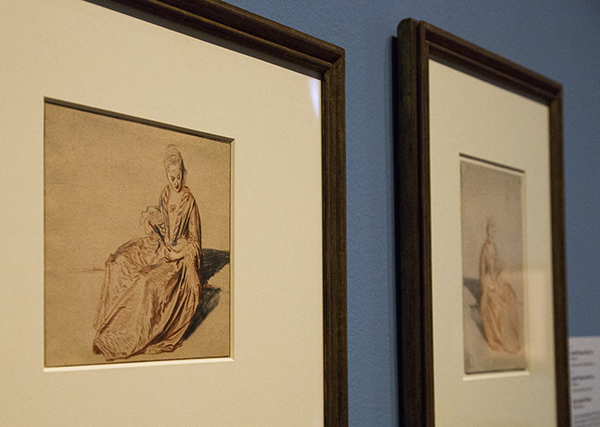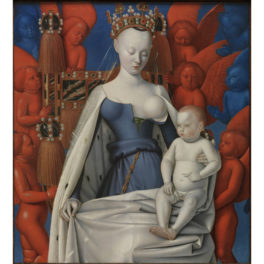French artist Jean-Antoine Watteau used a simple method to duplicate his drawings. Two are now reunited and on view side by side

Lady and her mirror image. Details of original and counterproof of Seated Woman with a Fan (details), early 18th century, Jean-Antoine Watteau. Image left: The J. Paul Getty Museum, 82.GB.164. Image right: Collection Ariane and Lionel Sauvage
Take a look at this pair of fashionable, fan-wielding ladies—they could almost be twins! Well, they are—in a sense.
The drawing on the left is an original composition by Jean-Antoine Watteau (1684-1721), and the one on the right is a “counterproof,” or mirror image, that he created after the original. Both are on view side by side in Rococo to Revolution: 18th-Century French Drawings from Los Angeles Collections, a selection of drawings on view July 1 through September 21 at the Getty Center.
How did these two sister drawings come to reunite in Los Angeles? Drawings curator Edouard Kopp explains:
One day, a private collector showed me the counterproof, and he knew it was after an original by Watteau. When we told him that we owned the original, he agreed to lend this piece so we could reunite them after all these years. What are the chances that both would end up in Los Angeles? Very low!
Watteau created this rococo Xerox for two reasons. First, making the counterproof was a way to stabilize the original drawing by removing the excess of chalk, which is a friable medium. Second, it created a duplicate image in reverse that could be kept as record, reworked, or given to another artist or a collector.

Installation view of the two drawings
To make a counterproof, an artist takes an original drawn in chalk and places a damp, blank sheet of paper on top. He or she then places them together into a printing press. The water from the blank secondary sheet absorbs the excess medium (in this case, red, black and white chalk), and the image is transferred.
How exact is the process? Pretty darn exact! You can see this for yourself in the exhibition by comparing the drawings themselves or by using an in-gallery touch screen, which demonstrates the incredible precision of this low-tech process that many artists used in the 1700s. The only major difference between the two is the color of the counterproof—due to the lesser density of the chalks on the counterproof, the colors in the latter appear paler

We know little about the original owner of Watteau’s counterproof, or its trajectory through the centuries—which makes it even more remarkable that, by chance, both of these drawings have ended up in Los Angeles collections. How these two navigated centuries of long-lost separation is unknown. The only thing that is certain is that this French woman remains vibrant and lovely, hundreds of years after she was put in front of the mirror.




Comments on this post are now closed.